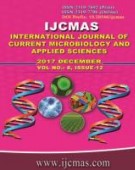


 National Academy of Agricultural Sciences (NAAS)
National Academy of Agricultural Sciences (NAAS)

|
PRINT ISSN : 2319-7692
Online ISSN : 2319-7706 Issues : 12 per year Publisher : Excellent Publishers Email : editorijcmas@gmail.com / submit@ijcmas.com Editor-in-chief: Dr.M.Prakash Index Copernicus ICV 2018: 95.39 NAAS RATING 2020: 5.38 |
Field experiment was conducted at Anbil Dharmalingam Agricultural College and Research Institute, Tamil Nadu Agricultural University, Tiruchirapalli, Tamil Nadu during rabi 2016-2017 to evaluate the weed management practices in transplanted rice under sodic soil. The experiment consisted of 12 treatments laid out in Randomized Complete Block Design with three replications consisting of three pre-emergence herbicides integrated with post emergence herbicides and one hand weeding at 40 DAT, two early post emergence herbicides and one post emergence herbicide, hand weeding twice at 20 and 40 DAT, compared with weed free and unweeded check. The weed flora of the experimental site consisted of Cynodon dactylon, Echinochloa colona and Panicum repens in grasses, Cyperus rotundus and Cyperus difformis in sedges and Ammannia baccifera, Ipomoea aquatica and Marsilea quadrifolia in broad leaved weeds. Grasses were found to be predominant category followed by sedges and broad leaved weeds. The results revealed that pre emergence application of bensulfuron methyl + pretilachlor at 60 + 600 g a.i. ha-1 on 3 DAT followed by hand weeding on 40 DAT recorded significantly higher grain and straw yield (4987 kg ha-1and 6841 kg ha-1) which remained at par with weed free check (4798 and 6741 kg ha-1). In terms of economics, highest net returns (Rs. 47765 ha-1) and B: C ratio (2.49) was realized compared to that weed free check (Rs. 42640 ha-1) and B: C ratio (2.25).
 |
 |
 |
 |
 |